Yijian Qin
JAQ: Joint Efficient Architecture Design and Low-Bit Quantization with Hardware-Software Co-Exploration
Jan 09, 2025



Abstract:The co-design of neural network architectures, quantization precisions, and hardware accelerators offers a promising approach to achieving an optimal balance between performance and efficiency, particularly for model deployment on resource-constrained edge devices. In this work, we propose the JAQ Framework, which jointly optimizes the three critical dimensions. However, effectively automating the design process across the vast search space of those three dimensions poses significant challenges, especially when pursuing extremely low-bit quantization. Specifical, the primary challenges include: (1) Memory overhead in software-side: Low-precision quantization-aware training can lead to significant memory usage due to storing large intermediate features and latent weights for back-propagation, potentially causing memory exhaustion. (2) Search time-consuming in hardware-side: The discrete nature of hardware parameters and the complex interplay between compiler optimizations and individual operators make the accelerator search time-consuming. To address these issues, JAQ mitigates the memory overhead through a channel-wise sparse quantization (CSQ) scheme, selectively applying quantization to the most sensitive components of the model during optimization. Additionally, JAQ designs BatchTile, which employs a hardware generation network to encode all possible tiling modes, thereby speeding up the search for the optimal compiler mapping strategy. Extensive experiments demonstrate the effectiveness of JAQ, achieving approximately 7% higher Top-1 accuracy on ImageNet compared to previous methods and reducing the hardware search time per iteration to 0.15 seconds.
Causal-Aware Graph Neural Architecture Search under Distribution Shifts
May 26, 2024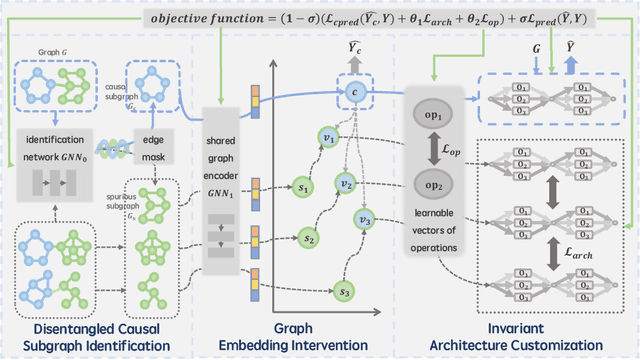
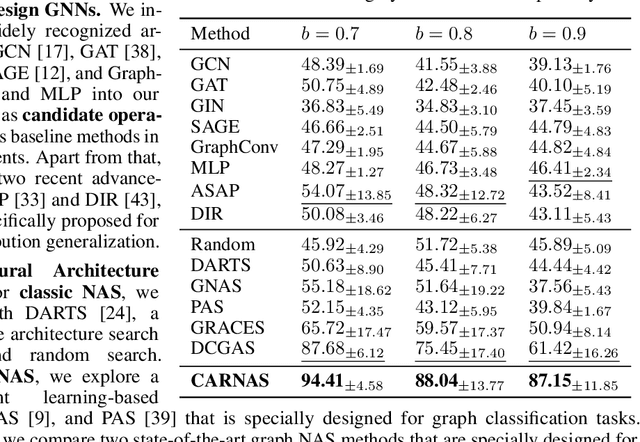
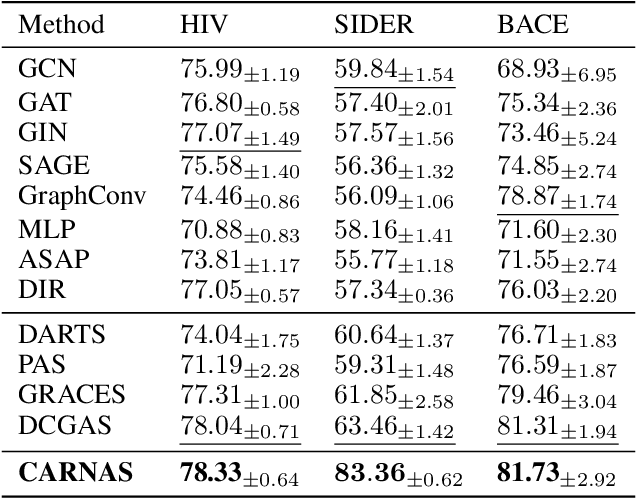
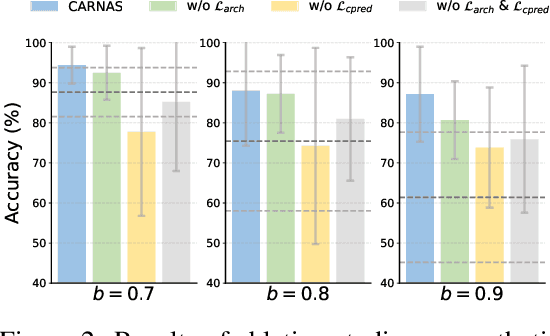
Abstract:Graph NAS has emerged as a promising approach for autonomously designing GNN architectures by leveraging the correlations between graphs and architectures. Existing methods fail to generalize under distribution shifts that are ubiquitous in real-world graph scenarios, mainly because the graph-architecture correlations they exploit might be spurious and varying across distributions. We propose to handle the distribution shifts in the graph architecture search process by discovering and exploiting the causal relationship between graphs and architectures to search for the optimal architectures that can generalize under distribution shifts. The problem remains unexplored with following challenges: how to discover the causal graph-architecture relationship that has stable predictive abilities across distributions, and how to handle distribution shifts with the discovered causal graph-architecture relationship to search the generalized graph architectures. To address these challenges, we propose Causal-aware Graph Neural Architecture Search (CARNAS), which is able to capture the causal graph-architecture relationship during the architecture search process and discover the generalized graph architecture under distribution shifts. Specifically, we propose Disentangled Causal Subgraph Identification to capture the causal subgraphs that have stable prediction abilities across distributions. Then, we propose Graph Embedding Intervention to intervene on causal subgraphs within the latent space, ensuring that these subgraphs encapsulate essential features for prediction while excluding non-causal elements. Additionally, we propose Invariant Architecture Customization to reinforce the causal invariant nature of the causal subgraphs, which are utilized to tailor generalized graph architectures. Extensive experiments demonstrate that CARNAS achieves advanced out-of-distribution generalization ability.
Exploring the Potential of Large Language Models in Graph Generation
Mar 21, 2024Abstract:Large language models (LLMs) have achieved great success in many fields, and recent works have studied exploring LLMs for graph discriminative tasks such as node classification. However, the abilities of LLMs for graph generation remain unexplored in the literature. Graph generation requires the LLM to generate graphs with given properties, which has valuable real-world applications such as drug discovery, while tends to be more challenging. In this paper, we propose LLM4GraphGen to explore the ability of LLMs for graph generation with systematical task designs and extensive experiments. Specifically, we propose several tasks tailored with comprehensive experiments to address key questions regarding LLMs' understanding of different graph structure rules, their ability to capture structural type distributions, and their utilization of domain knowledge for property-based graph generation. Our evaluations demonstrate that LLMs, particularly GPT-4, exhibit preliminary abilities in graph generation tasks, including rule-based and distribution-based generation. We also observe that popular prompting methods, such as few-shot and chain-of-thought prompting, do not consistently enhance performance. Besides, LLMs show potential in generating molecules with specific properties. These findings may serve as foundations for designing good LLMs based models for graph generation and provide valuable insights and further research.
Disentangled Representation Learning with Large Language Models for Text-Attributed Graphs
Nov 06, 2023Abstract:Text-attributed graphs (TAGs) are prevalent on the web and research over TAGs such as citation networks, e-commerce networks and social networks has attracted considerable attention in the web community. Recently, large language models (LLMs) have demonstrated exceptional capabilities across a wide range of tasks. However, the existing works focus on harnessing the potential of LLMs solely relying on prompts to convey graph structure information to LLMs, thus suffering from insufficient understanding of the complex structural relationships within TAGs. To address this problem, in this paper we present the Disentangled Graph-Text Learner (DGTL) model, which is able to enhance the reasoning and predicting capabilities of LLMs for TAGs. Our proposed DGTL model incorporates graph structure information through tailored disentangled graph neural network (GNN) layers, enabling LLMs to capture the intricate relationships hidden in text-attributed graphs from multiple structural factors. Furthermore, DGTL operates with frozen pre-trained LLMs, reducing computational costs and allowing much more flexibility in combining with different LLM models. Experimental evaluations demonstrate the effectiveness of the proposed DGTL model on achieving superior or comparable performance over state-of-the-art baselines. Additionally, we also demonstrate that our DGTL model can offer natural language explanations for predictions, thereby significantly enhancing model interpretability.
LLM4DyG: Can Large Language Models Solve Problems on Dynamic Graphs?
Oct 26, 2023Abstract:In an era marked by the increasing adoption of Large Language Models (LLMs) for various tasks, there is a growing focus on exploring LLMs' capabilities in handling web data, particularly graph data. Dynamic graphs, which capture temporal network evolution patterns, are ubiquitous in real-world web data. Evaluating LLMs' competence in understanding spatial-temporal information on dynamic graphs is essential for their adoption in web applications, which remains unexplored in the literature. In this paper, we bridge the gap via proposing to evaluate LLMs' spatial-temporal understanding abilities on dynamic graphs, to the best of our knowledge, for the first time. Specifically, we propose the LLM4DyG benchmark, which includes nine specially designed tasks considering the capability evaluation of LLMs from both temporal and spatial dimensions. Then, we conduct extensive experiments to analyze the impacts of different data generators, data statistics, prompting techniques, and LLMs on the model performance. Finally, we propose Disentangled Spatial-Temporal Thoughts (DST2) for LLMs on dynamic graphs to enhance LLMs' spatial-temporal understanding abilities. Our main observations are: 1) LLMs have preliminary spatial-temporal understanding abilities on dynamic graphs, 2) Dynamic graph tasks show increasing difficulties for LLMs as the graph size and density increase, while not sensitive to the time span and data generation mechanism, 3) the proposed DST2 prompting method can help to improve LLMs' spatial-temporal understanding abilities on dynamic graphs for most tasks. The data and codes will be open-sourced at publication time.
Large Graph Models: A Perspective
Aug 28, 2023Abstract:Large models have emerged as the most recent groundbreaking achievements in artificial intelligence, and particularly machine learning. However, when it comes to graphs, large models have not achieved the same level of success as in other fields, such as natural language processing and computer vision. In order to promote applying large models for graphs forward, we present a perspective paper to discuss the challenges and opportunities associated with developing large graph models. First, we discuss the desired characteristics of large graph models. Then, we present detailed discussions from three key perspectives: representation basis, graph data, and graph models. In each category, we provide a brief overview of recent advances and highlight the remaining challenges together with our visions. Finally, we discuss valuable applications of large graph models. We believe this perspective paper is able to encourage further investigations into large graph models, ultimately pushing us one step closer towards artificial general intelligence (AGI).
NAS-Bench-Graph: Benchmarking Graph Neural Architecture Search
Jun 18, 2022



Abstract:Graph neural architecture search (GraphNAS) has recently aroused considerable attention in both academia and industry. However, two key challenges seriously hinder the further research of GraphNAS. First, since there is no consensus for the experimental setting, the empirical results in different research papers are often not comparable and even not reproducible, leading to unfair comparisons. Secondly, GraphNAS often needs extensive computations, which makes it highly inefficient and inaccessible to researchers without access to large-scale computation. To solve these challenges, we propose NAS-Bench-Graph, a tailored benchmark that supports unified, reproducible, and efficient evaluations for GraphNAS. Specifically, we construct a unified, expressive yet compact search space, covering 26,206 unique graph neural network (GNN) architectures and propose a principled evaluation protocol. To avoid unnecessary repetitive training, we have trained and evaluated all of these architectures on nine representative graph datasets, recording detailed metrics including train, validation, and test performance in each epoch, the latency, the number of parameters, etc. Based on our proposed benchmark, the performance of GNN architectures can be directly obtained by a look-up table without any further computation, which enables fair, fully reproducible, and efficient comparisons. To demonstrate its usage, we make in-depth analyses of our proposed NAS-Bench-Graph, revealing several interesting findings for GraphNAS. We also showcase how the benchmark can be easily compatible with GraphNAS open libraries such as AutoGL and NNI. To the best of our knowledge, our work is the first benchmark for graph neural architecture search.
AutoGL: A Library for Automated Graph Learning
May 04, 2021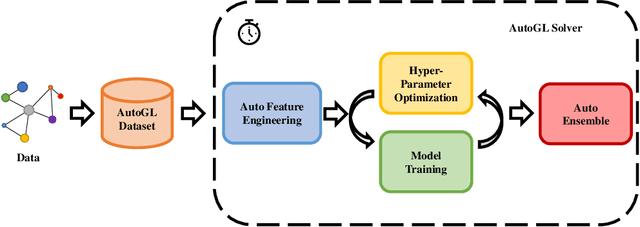
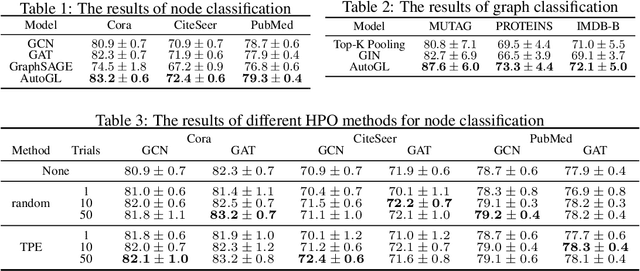

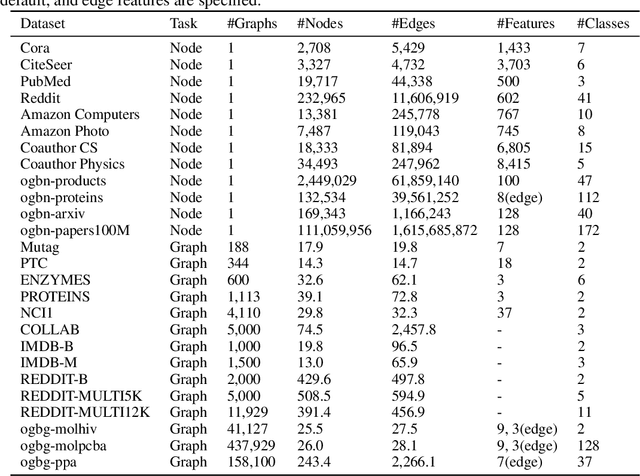
Abstract:Recent years have witnessed an upsurge of research interests and applications of machine learning on graphs. Automated machine learning (AutoML) on graphs is on the horizon to automatically design the optimal machine learning algorithm for a given graph task. However, none of the existing libraries can fully support AutoML on graphs. To fill this gap, we present Automated Graph Learning (AutoGL), the first library for automated machine learning on graphs. AutoGL is open-source, easy to use, and flexible to be extended. Specifically, we propose an automated machine learning pipeline for graph data containing four modules: auto feature engineering, model training, hyper-parameter optimization, and auto ensemble. For each module, we provide numerous state-of-the-art methods and flexible base classes and APIs, which allow easy customization. We further provide experimental results to showcase the usage of our AutoGL library.
 Add to Chrome
Add to Chrome Add to Firefox
Add to Firefox Add to Edge
Add to Edge